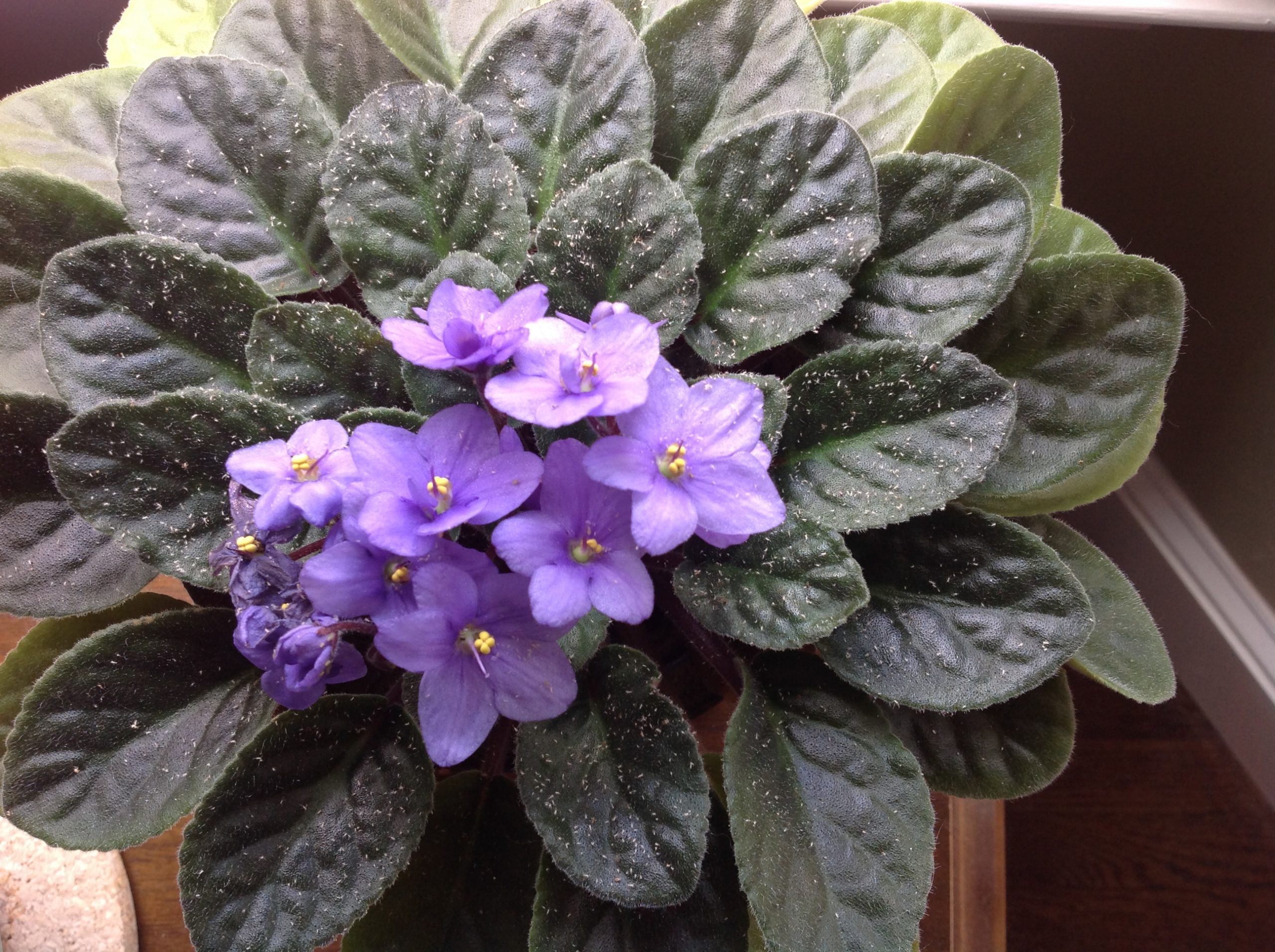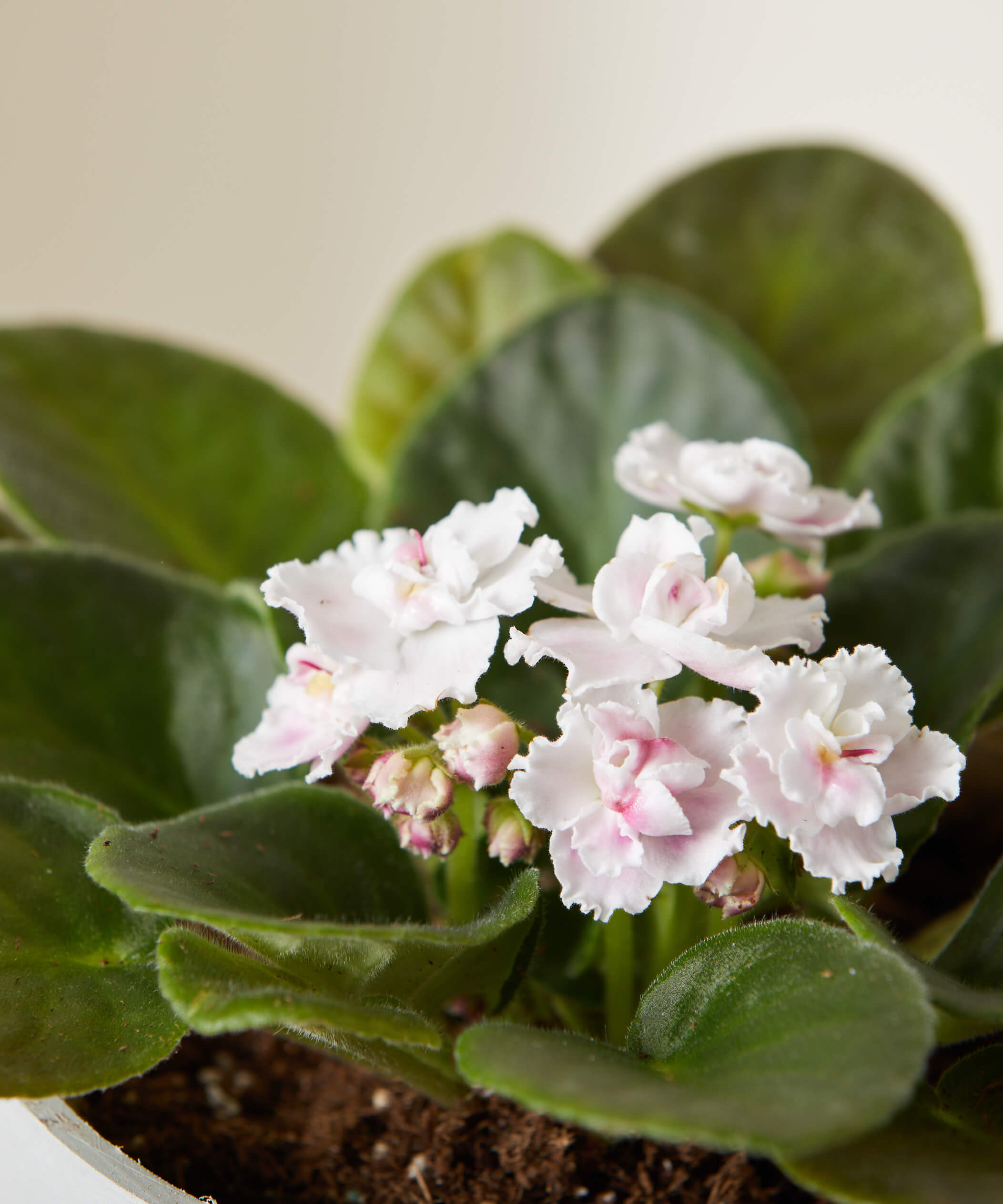When you purchase through links on our site, we may earn an affiliate commission. Here’s how it works.
White powder on African violet leaves is an indication that your plant has been infested by a nasty fungal disease. Although powdery mildew on African violets isn’t usually deadly, it can definitely impact the overall health and appearance of leaves and stems, stunt plant growth, and reduce blooming substantially. If left untreated, leaves may dry and turn yellow or brown. Wondering what to do about African violets with powdery mildew? Looking for tips on African violet fungal control? Read on.
African violets are stunning flowering houseplants that can brighten up any indoor space. But you may notice some problems with your plant like white spots appearing on the leaves. While concerning there are several common reasons for white spots on african violet leaves. Luckily, most causes are easy to identify and treat at home.
Common Causes of White Spots on African Violet Leaves
Here are the most frequent causes of white spots on african violet leaves and how to identify them:
-
Powdery Mildew – A fungal disease that shows up as a white, powdery substance on leaves. Leaves may also yellow, brown, curl, or become distorted. Caused by excessive moisture and poor air circulation.
-
Pests – Insects like mealybugs, aphids, and thrips can all cause stippling (small white spots) as they feed on leaves. Other signs include leaf curling/distortion, yellowing, browning, and presence of the bugs.
-
Nutrient Deficiency – Lack of nutrients like nitrogen and iron leads to yellowing and white spots. Other symptoms include slow growth and leaf drop.
-
Hard Water Minerals – White spots only on areas of leaves exposed to water indicates mineral buildup from hard water. Leaves may also feel sticky.
-
Sunburn – Direct sun scorches leaves, causing white spots/patches, dryness, brittleness, discoloration. Only affects exposed leaf surfaces
-
Chemical Damage – Chemicals like cleaning products, over-fertilizing, fluoridated water can burn leaves, creating white spots, leaf loss, discoloration, wilting, and stunted growth
How to Prevent White Spots on African Violet Leaves
Here are some tips to avoid white spots on your african violet:
-
Water at the base of the plant to prevent fungal/bacterial diseases. Provide humidity through pebble trays or humidifiers, not misting.
-
Ensure proper air circulation and indirect sunlight to prevent powdery mildew. Avoid overcrowding.
-
Fertilize regularly during growing seasons for nutrient health. Use an african violet fertilizer.
-
Inspect frequently for pests and remove them. Keep leaves clean and debris-free.
-
Filter water or use distilled/rainwater to prevent mineral buildup. Let tap water sit out before using.
-
Place in bright indirect light, not direct sun, to avoid sunburn. Filter sunlight through sheer curtains.
-
Carefully follow all product labels if using chemicals around plants. Check roots and repot after any chemical exposure.
How to Treat White Spots on African Violet Leaves
If your african violet already has white spots, here are some treatment tips:
-
Powdery mildew – Prune affected leaves. Use baking soda spray, copper fungicide, neem oil, or milk solution on leaves. Improve air circulation.
-
Pests – Wipe or spray leaves with insecticidal soap, neem oil or alcohol/water solution. Remove badly infested leaves. Apply multiple times.
-
Nutrient deficiency – Apply balanced fertilizer or specific nutrients plants are lacking. Add compost or manure to potting mix.
-
Hard water buildup – Wipe leaves with soft cloth and distilled water or dip in diluted vinegar. Use rain or distilled water for watering.
-
Sunburn – Move plant to shade. Increase humidity. Damaged leaves will eventually recover.
-
Chemical damage – Wash leaves gently with clean water. Trim damaged roots and repot in fresh mix if needed. Move plant away from chemicals.
With proper care, your african violet will make a full recovery from white spots on its leaves. Be sure to identify the cause and take action right away before the spots spread. With a little time and TLC, your plant will be back to its beautiful self!

The Grow-How Team’s tips for when your African violet has spots on its leaves. Learn why your African violet has spots and what you can do to fix the issue.

Fungal Disease
The African violet plant can develop spots on its leaves from being misted or splashed with water. The African violet’s fuzzy leaves can trap moisture causing fungal or bacterial leaf spot to form. To avoid this, always water your African violet at the soil level by carefully lifting the leaves or with the bottom-watering method, never on the leaves or the center of the plant. If you need to provide extra humidity do so by placing it over a pebble tray or putting a humidifier nearby instead of misting.
If the spots on your African violet are white and powdery looking, this could be a fungal disease called powdery mildew. Powdery mildew could have formed because the plant lacks air circulation in a hot and humid environment. When combined with a lack of light, these conditions create the perfect environment for powdery mildew to grow.
To help the plant, prune off the dead stems and leaves and isolate them from other plants since fungal issues can spread quickly between plants. Place the plant somewhere with more air movement and more light, and treat the plant with a copper fungicide. If not caught in time, powdery mildew is sometimes fatal to African violets and other indoor plants.
Overwatering
Overwatering an African violet can also cause spots to appear on the leaves. Too much moisture in the soil of a houseplant can sometimes cause edema. Edema shows up as spots most often on the underside of the leaves, but occasionally on the top. These spots have a reddish coloration and will luckily not spread once watering is corrected. Eventually, this dead plant tissue will fall away, or you can trim using sharp, clean pruning scissors.
Water when the soil volume is 25% dry. This plant likes to be kept moist, but does not like to sit in soggy soil. Avoid getting the leaves wet, and the bottom-watering method is recommended. Place your plant in a sink filled with 2-4″ of water. Leave the plant to soak for up to 45 minutes. Test the top of the soil for moisture. If it still feels dry water a little from the top. When your plant’s soil is evenly damp, drain the sink/tub and allow the plant to rest while it drains thoroughly.
Temperature
If your plant has been exposed to temperatures below 55°F, it can cause damage. On the other hand, exposure to direct sun can also cause spots. Be sure to keep the plant’s leaves from pressing up against window panes, which can become hotter or colder than the indoor air.
Causes of Powdery Mildew on African Violets
Powdery mildew thrives where conditions are warm and humid and air circulation is poor. Temperature fluctuations and low light can also contribute to fungal disease. Treating African violets with powdery mildew means taking precautions to avoid these conditions.
What is that white stuff on my african violets ? … Powdery Mildew? … What to do?
FAQ
How do you treat white spots on African violets?
To help the plant, prune off the dead stems and leaves and isolate them from other plants since fungal issues can spread quickly between plants. Place the plant somewhere with more air movement and more light, and treat the plant with a copper fungicide.
What is the white mold on my African violets?
Powdery Mildew grows superficially on the leaves and flowers of African Violets, covering them with a light gray powder. If left untreated, Powdery Mildew will cause discoloration of the affected leaves and flowers. Eventually, the affected parts of your African Violet will begin to wither and die.
How do I get rid of little white bugs on my African violets?
Light infestations of mealybugs can be controlled by removing them with a cotton swab dipped in rubbing (isopropyl) alcohol. Repeat as needed.
How do you fix white spots on leaves?
Gently rinse the roots. Some would suggest spraying with a pesticide; I never recommend such. Make a warm plant wash with water and ONE drop of dawn. Gently wash the white spots and rinse with warm bottled (or boiled and cooled) water until the spots are gone. If it is powdery mildew, this process will kill it.
